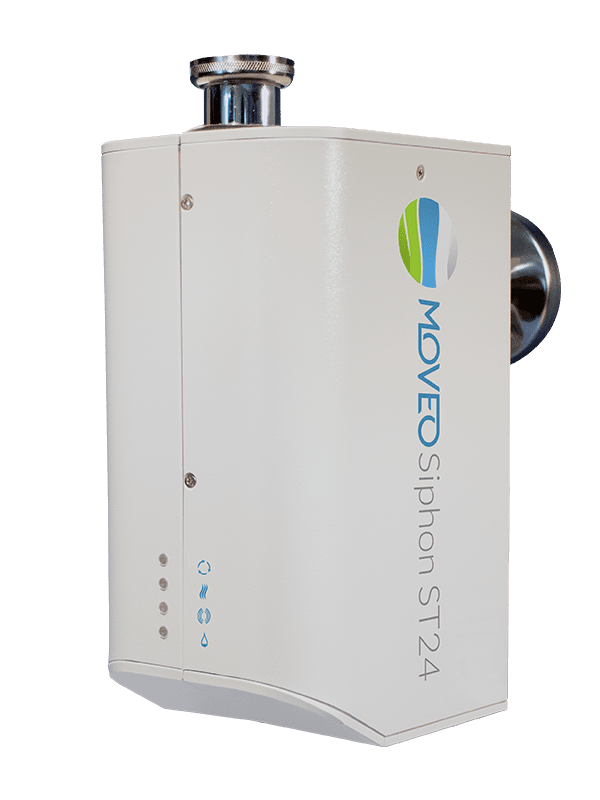MoveoSiphon ST24
The self-disinfecting trap for clinical sanitary areas.
- Disinfection through heat
- Prevention of biofilm formation

Prevention of Hospital-Acquired Infections (HAI)
HAIs or nosocomial infections are a major threat to patient safety.
They require an efficient analysis and effective control. But in particular sustainable prevention measures.
Classical prevention strategies are the interruption of the infection transmission by reinforcing hand hygiene, isolation measures and surveillance. However, in case of HAI outbreaks that have been caused by multidrug-resistant gram-negative bacteria (MDRGN bacteria), wastewater systems have to be considered as potential source of germs and therefore to be investigated. Wastewater and biofilm in drain systems provide ideal conditions for colonisation and persistence of MDRGN bacteria like Pseudomonas aeruginosa, Acinetobacter baumanii, Klebsiella pneumonia or Escherichia coli.
There have been several reports in the news on outbreak situations caused by contaminated siphons in patient rooms. Odour traps under sinks and baby bath tubs are open pathogen reservoirs and sources for emitting bacteria.
Water flowing into the sink drain produces aerosols on the surface of the seal water which can - depending on the bacterial contamination of the seal water - lead to a transmission of bacteria from the seal water to the hands of patients or to the surrounding surfaces.
The MoveoSiphon ST24 provides an effective outbreak protection. It continuously and completely cleans and disinfects the trap liquid in the odour trap under the sink automatically. The trap liquid is disinfected by means of thermal disinfection whilst the vibration cleaning prevents a biofilm formation. Thus, the odour trap is permanently excluded being a pathogen reservoir and source of outbreaks.
Sensitive areas in hospitals as neonatal units, intensive care units or transplant units could benefit from this kind of “sink disinfection” as the prevention of a retrograde contamination by infected aerosols is particularly important for seriously ill patients and premature babies. The hygiene siphon prevents the outbreak of HAI caused by waterborne bacteria arising from the water in the odour trap.
As a result, the antibiotic consumption is reduced and the incidence of resistance to antibiotics decreases.
The problem area
Sink drains under wash basins in clinics and hospitals are open pathogen reservoirs and sources for emitting bacteria.1,2,3 They contain on average 105-1010 CFU/ml of bacteria, including 103 - 106 CFU/ml of gram-negative rods.4
Water flowing into the sink drain produces aerosols on the surface of the seal water which can emit the bacteria up to a distance of 1.5 metres around the siphon.5
In case of bacterial contamination of the seal water of >105 CFU/ml so many microorganisms are carried into the air in the room that a measureable transmission of bacteria from the seal water to the hands of patients or staff takes place.2,6
Numerous clinical investigations prove:
conventional sink drains do not fulfi l the high hygiene standards needed in invasive intensive care.4,5
Sources
1) Sissoko et al. (2004), Hygiene & Medizin, 29 (12): 451-455
2) Sissoko et al.(2004), Hygiene & Medizin, 29 (1/2): 12-16
3) Sissoko und Sütterlin (2004), Vortrag 7. Internionaler Kongress der Deutschen Gesellschaft für Krankenhaushygiene DGKH, Berlin
4) Sissoko et al.(2005), Hygiene & Medizin, 30 (4): 72-76
5) Döring et al., Epidemiol. Infect. (1993), 110: 427-436
6) de Jonge E. et al., Journal of Hospital Infection, https://doi.org/10.1016/j.jhin.2019.01.003 Effects of a disinfection device on colonization of sink-drains and patients during a prolonged outbreak with multiresistant Pseudomonas aeruginosain an ICU
The MoveoSiphon operating function
The thermo disinfection carried out by the MoveoSiphon fulfils at least the standards of the technical process of pasteurization by means of heating (10 to 15 seconds at 85°C). In the process the unit heats up to the set temperature (85°C) and slowly cools down while the subsequent vibration cleaning takes place.
Once the minimum set temperature has been reached (75°C), the heating process and thus the disinfection cleaning cycle recommence once again.
If no interruption is caused by additional water infl ow, then the entire process is completed after 5-6 cycles in a period of approximately one hour and the MoveoSiphon switches into standby mode until water fl ows in again.
The functionality in a video
Learn more about the functionality of the MoveoSiphon ST24 in the video.
The most important facts about the MoveoSiphon
ENVIRONMENTALLY FRIENDLY
7-log stages
Fast effect
Thermal disinfection
Free of biofilms
Reduction of nosocomial infections
Patient colonization and the occurrence of waterborne healthcare-associated infections can be prevented.2
Economic
Using the MoveoSiphon can help reduce antibiotic consumption and shorten isolation periods.3
1) Hygiene Nord GmbH/Greifswald, Prüfbericht A 13228, 17.12.2013;
2) Sissoko und Sütterlin (2004), Vortrag 7. internationaler Kongress der Deutschen Gesellschaft für Krankenhaushygiene DGKH, Berlin;
3) Monatsschrift Kinderheilkunde 2013 (Suppl 2) DGKJ-PO-12-11
Strategy
Growth through innovation in the sanitary hygiene area and the development of international sales partners or cooperation.
Our vision
“We make a difference in hygiene and disinfection”
It is our intention to be true to this motto, to make a useful contribution to the prevention of nosocomial infections.
We think the employees of our company are the basis of our success. That is why we place value on our employees providing their skills and their performance for the benefit of the company and extend their knowledge continuously.
News & Events
Here you’ll find updates on current developments, product innovations,
expert articles, studies, and events from the field of hospital hygiene.

MoveoSiphon ST 24: Prevention of Horizontal Gene Transfer (HGT)

Multidrug-resistant Gram-negative bacteria in sink traps
Nosocomial and community-acquired infections are still the major challenge of the health care system....

 Deutsch
Deutsch  English
English 
